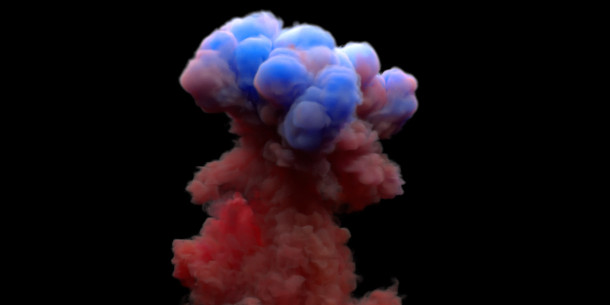LuxCoreRender 2.4 and BlendLuxCore 2.4 ship

Smoke rendered in LuxCoreRender via its BlenderLuxCore integration plugin. The 2.4 release of the open-source physically based renderer adds support for Blender’s mantaflow fluid simulation framework.
The LuxCoreRender team has released version 2.4 of the open-source physically based renderer, adding a new CUDA backend for Nvidia GPUs and support for out-of-core and viewport GPU rendering.
Other changes in the core renderer include thin-film interference for mimicking effects like oil films and soap bubbles, support for LUTs in .cube format, and improved sampling and light caching.
BlendLuxCore, the Blender integration plugin, gets support for Mantaflow simulations, a new albedo mode for look development, and a new library of readymade architectural models and materials.
A hybrid CPU/GPU unbiased render engine, formerly known as LuxRender
Formerly known as LuxRender, LuxCoreRender was rebooted in 2018 with a change of name, a new project website, forum and online documentation.
It’s a physically based render engine with a range of production features and, as of LuxCoreRender 2.0, supports hybrid C++/OpenCL rendering on CPUs and GPUs.
The 2.0 release also reduced the number of DCC tools into which the renderer is integrated: whereas LuxRender used to have plugins for a range of apps, LuxCoreRender only supports Blender.
New in LuxCoreRender 2.4: better GPU rendering performance
LuxCoreRender 2.4 includes a number of changes intended to improve GPU rendering performance, including a new CUDA backend, decribed as “a bit faster” on Nvidia GPUs than the existing OpenCL version.
The software also now supports out-of-core rendering on AMD and Nvidia GPUs, making it possible to render scenes too large to fit into GPU memory without the performance hit this traditionally entailed.
In addition, the software’s material and texture evaluation code has been rewritten so that kernel compilation is only required on installation, rather than with every change in scene settings.
The change makes it feasible to use the OpenCL backend as a viewport renderer, although it can increase total render times for simple scenes: complex scenes are less affected. You can find more details here.

LuxCoreRender 2.4: thin-film interference, better light caching, support for .cube LUTs
New features in the core renderer include support for thin-film interference, making it possible to mimic real-world iridescence effects, such as those seen in oil films on water, soap bubbles and heated metal.
It is available in LuxCoreRender’s glass materials and general-purpose Disney Principled material.
Workflow and performance improvements include a rewrite of the environment light cache, which should result in less noisy images when rendering illumination from light portals.
The PhotonGI cache for indirect light and caustics has also been extended to support light groups.
In addition, there are new preset sampling patterns for renders tailored to progressive previews, final-quality renders and out-of-core rendering.
Pipeline improvements include support for LUTs in .cube format when colour grading output.
BlendLuxCore 2.4: Mantaflow support, new albedo render mode for look dev work
As well as the changes to the core renderer, the Blender plugin gets support for smoke simulations generated in mantaflow, the new fluid simulation framework added in Blender 2.82.
The update also introduces a new albedo render mode, intended to provide fast interactive previews of a scene during shot layout and look development work.
The new mode, which replaces the native look dev mode of Blender’s Eevee renderer, shows only the albedo AOV of a material, improving interactive performance.
The Blender plugin also now comes with a link to an online library of architectural models and materials created by Charles Nandeya Ehouman (Sharlybg), shown in the video above.
Users can populate interior scenes by adding furniture and ornaments from the library directly within Blender. The assets are available under a Creative Commons Attribution licence.
System requirements and availability
LuxCoreRender 2.4 is available under an Apache 2.0 licence for Windows, Linux and macOS. BlendLuxCore 2.4 is compatible with Blender 2.82+.
Read an overview of the new features on the LuxCoreRender website
